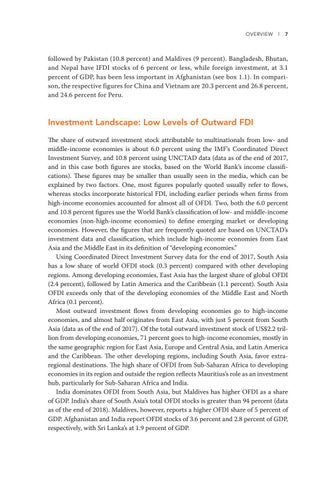OVERVIEW l 7
followed by Pakistan (10.8 percent) and Maldives (9 percent). Bangladesh, Bhutan, and Nepal have IFDI stocks of 6 percent or less, while foreign investment, at 3.1 percent of GDP, has been less important in Afghanistan (see box 1.1). In comparison, the respective figures for China and Vietnam are 20.3 percent and 26.8 percent, and 24.6 percent for Peru.
Investment Landscape: Low Levels of Outward FDI The share of outward investment stock attributable to multinationals from low- and middle-income economies is about 6.0 percent using the IMF’s Coordinated Direct Investment Survey, and 10.8 percent using UNCTAD data (data as of the end of 2017, and in this case both figures are stocks, based on the World Bank’s income classifications). These figures may be smaller than usually seen in the media, which can be explained by two factors. One, most figures popularly quoted usually refer to flows, whereas stocks incorporate historical FDI, including earlier periods when firms from high-income economies accounted for almost all of OFDI. Two, both the 6.0 percent and 10.8 percent figures use the World Bank’s classification of low- and middle-income economies (non-high-income economies) to define emerging market or developing economies. However, the figures that are frequently quoted are based on UNCTAD’s investment data and classification, which include high-income economies from East Asia and the Middle East in its definition of “developing economies.” Using Coordinated Direct Investment Survey data for the end of 2017, South Asia has a low share of world OFDI stock (0.3 percent) compared with other developing regions. Among developing economies, East Asia has the largest share of global OFDI (2.4 percent), followed by Latin America and the Caribbean (1.1 percent). South Asia OFDI exceeds only that of the developing economies of the Middle East and North Africa (0.1 percent). Most outward investment flows from developing economies go to high-income economies, and almost half originates from East Asia, with just 5 percent from South Asia (data as of the end of 2017). Of the total outward investment stock of US$2.2 trillion from developing economies, 71 percent goes to high-income economies, mostly in the same geographic region for East Asia, Europe and Central Asia, and Latin America and the Caribbean. The other developing regions, including South Asia, favor extraregional destinations. The high share of OFDI from Sub-Saharan Africa to developing economies in its region and outside the region reflects Mauritius’s role as an investment hub, particularly for Sub-Saharan Africa and India. India dominates OFDI from South Asia, but Maldives has higher OFDI as a share of GDP. India’s share of South Asia’s total OFDI stocks is greater than 94 percent (data as of the end of 2018). Maldives, however, reports a higher OFDI share of 5 percent of GDP. Afghanistan and India report OFDI stocks of 3.6 percent and 2.8 percent of GDP, respectively, with Sri Lanka’s at 1.9 percent of GDP.

